The folks behind the Plimoth Plantation 17th century jacket project have been busy! They’ve brought another new metal thread onto the market, one which was used in 17th century raised embroidery, but eventually fell out of use and disappeared from the market. We’ve heard the story before – remember that these are the same folks behind the Gilt Sylke Twist now once again available to the embroiderer after a couple centuries of absense! Silk Purl is the new thread, and here’s a look at it…
Silk Purl is made up of a fine copper wire wrapped with filament silk, then turned into a tight coil. If you’re familiar with goldwork embroidery threads (real metal threads for embroidery), you can compare Silk Purl with regular purls used in goldwork. (You can see some gold purls being worked in my beetle wing goldwork project from a while ago, if you want!) The difference between regular gold or gilt purls and Silk Purl is that Silk Purl is covered in silk, which means it’s colored and shiny like silk and the coil is a little fatter than the coil you’d see on a regular gold or gilt purl.
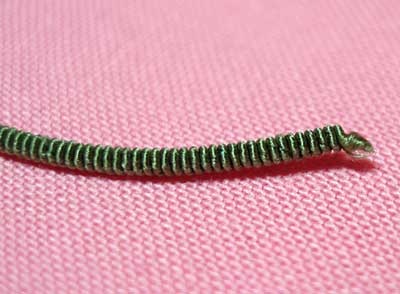
Silk Purl is a really incredible thread! I realize that trends and tastes change as the years pass, but it’s so hard to imagine that a thread this interesting could just fade from existence and not be resurrected again for some centuries!
I love the look and the feel of the Silk Purl. It feels hard (due to the wire) but smooth (thanks to the silk!), a little boingy, and bumpy.
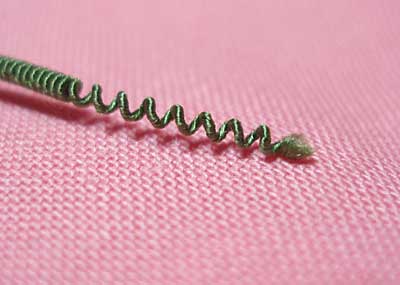
Just like with regular purls used in goldwork, if you stretch the Silk Purl, you’ll get an elongated spring-looking length of wire that will not close back on itself.
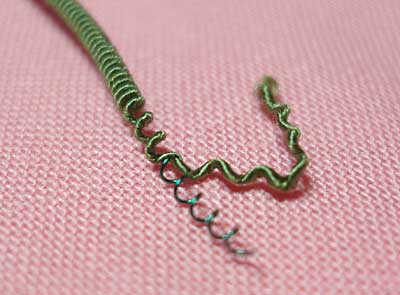
If you unwrap the spring, you can see the colored wire that forms the core of the metal thread, and the silk, of course, which becomes very limp and silk-like. It’s nice silk and it feels great to the touch!
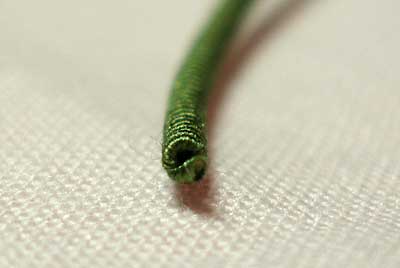
Silk Purl is hollow in the center, so small pieces cut from the length of the Silk Purl can be sewn on just like bugle beads. According to Tricia Wilson Nguyen, the lady behind the research that resurrected these historic threads, Silk Purl was sewn on in a number of ways: couched in long wavy lines (sometimes with the Silk Purl slightly stretched – think human of animal hair in 17th century embroidery); sewn on in loops; or sewn on in a kind of chipwork method to fill an area, as is done with check purl. Tricia included some great photos of historical examples of Silk Purl in use in her last newsletter from Thistle Threads. If you haven’t signed up for her newsletter, you should. Though they don’t come out often, when they do, they’re full of interesting tidbits on historical embroidery.
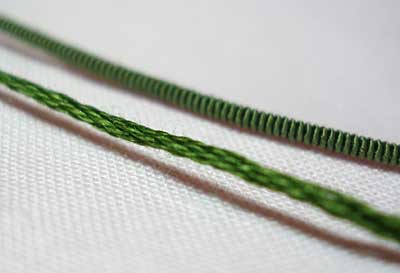
To give you an idea of the size of Silk Purl, I lined a piece up with a regular piece of 6-stranded DMC cotton, which is what you see here in the foreground of the photo.
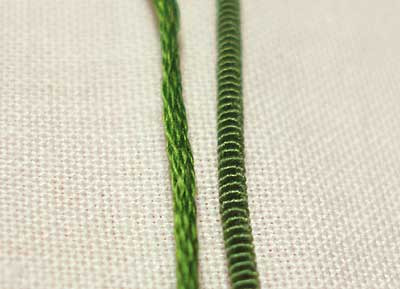
Although in size, Silk Purl is more solidly round and stands up off the fabric, you can see that it isn’t too far in size from a regular piece of DMC (with all 6 strands still in tact).
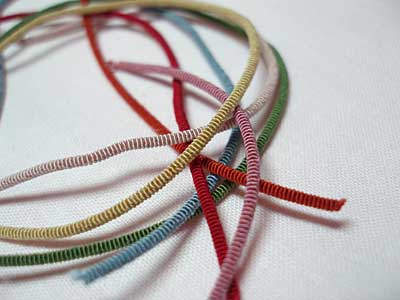
Silk Purl comes in colors to that match Gilt Sylke Twist, with about 8 colors available right now. It is uncertain whether the thread will continue to be manufactured, and the colors presently being manufactured are short in quantity, so if you see a color you like over at Thistle Threads, don’t delay in ordering it – you never know when it may be gone again for good.
I ordered a sample pack of the colors, to see what Silk Purl was all about. I think it’s a really neat thread, and that those interested in stumpwork or any dimensional embroidery techniques, or goldwork, would find the thread inspiring. I’ve been mulling over all kinds of possible uses ever since the package arrived in the mail, and I’ve added it to my list of things to play with in the near future! I’m looking forward to it!







Very nice looking! I think it would be fun to use this in place of some of my bullion stitches. Be sure to show us some of your experiments.
I've ordered a sampler pack and 1 yard of "Straw" (for flower centres, done in loops of the purl) – tho I'm looking forward to getting more colours.
If you google "silk purl" and "silk covered purl" you can find other suppliers, with other colours – although I'm unable to comment on quality.
Also note there is the coloured metal purl – comes in turquoise, blue, green, rust etc etc but it's not silk covered – it's just like the regular gold purl, only in a particular colour and doesn't have the lushness of the silk covering (it's easy to get confused when you see a list of "coloured purl" – I certainly have!)
If you look up
Museum : Museum of Fine Arts, Boston
Date : late 17th to early 18th C
Accession Number : 88.531
Link : http://www.mfa.org/collections/search_art.asp?coll_keywords=88.531
you will find a piece that is done entirely in couched silk purl!
Great pictures and explanation about these threads. Someday I hope to acquire some and see what I can do with it!